
Anxieties and worries of all kinds are common in children, necessarily part of healthy development, but also, when they interfere with the child’s functioning, the most common pediatric mental health problems. From separation anxiety to social anxiety to school avoidance to phobias to generalized anxiety disorder, many children’s lives are at some point touched by anxiety that gets out of hand, nytimes.com wrote.
“I often tell parents, anxiety and fears are totally a normal and healthy part of growing up,” said Dr. Sabrina Fernandez, an assistant professor of pediatrics at the University of California, San Francisco, who has written about strategies for primary care doctors to use in dealing with anxiety disorders.
“I worry that it’s becoming something more when it interferes with the child’s ability to do their two jobs: To learn in school and to make friends.”
Children whose lives are being seriously derailed by their anxieties often get psychotherapy or medication, or both. And a meta-analysis published in November in JAMA looked at the two best-studied treatments for anxiety disorders, cognitive behavioral therapy and psychotropic medication. The technique of a meta-analysis allows scientists to pull in a whole range of different studies, weight the results according to the size and rigor of the research, and then consider the wider array of data gleaned from multiple investigations.
“We included panic disorder, social anxiety disorder, specific phobias, generalized anxiety disorder and separation anxiety,” said the lead author, Zhen Wang, an associate professor of health services research at the Mayo Clinic College of Medicine and Science (they did not include children with post-traumatic stress disorder or obsessive-compulsive disorder).
The study looked at the effectiveness of treatments in reducing the symptoms of anxiety, and at ending the anxiety disorder state. And they also looked at any reports of adverse events associated with the treatments, from sleep disturbances to suicide.
The authors examined 115 different studies, for a total of 7,719 patients, and concluded that certain kinds of antidepressant medications — especially the selective serotonin reuptake inhibitors, or S.S.R.I.s — were effective in reducing anxiety symptoms in children; the mean age of the children in the study was 9.2 years, with a range of 5 to 16.
There were only a few studies that directly compared them, but they suggest that cognitive behavioral therapy may be even more effective at reducing symptoms and at resolving the anxiety disorders, and that the combination of medication and C.B.T. may be better than either was alone. The drugs were associated with a variety of adverse events, though they did not find the association with suicide attempts that has led to a black box warning on S.S.R.I.s. Still, they have not ruled out those dangers: “The difference may be due to underreporting and monitoring of suicide attempts in clinical trials,” Dr. Wang said.
Dr. Stephen P.H. Whiteside, the director of the Pediatric Anxiety Disorders Clinic at the Mayo Clinic, who was one of the authors of the meta analysis, said, “if your child has difficulties with anxiety, first of all, it’s treatable. There are a variety of interventions that can be helpful.”
So which of those children — the parent-clinger, the dog-fearer, the school-avoider — needs psychotherapy or psychopharmacology?
“Anxiety happens in kids,” said Dr. Christopher K. Varley, a professor in the department of psychiatry at the University of Washington School of Medicine in Seattle. “It does not always need treatment.”
And it does not always look exactly like what adults think of as anxiety, he said. Kids can have physical symptoms, or become disruptive; headaches and stomachaches and tantrums can all mean that a child is anxious.
“The important questions to me are, is this a problem, is it getting in the way of functioning, is it creating stress for the child and the family, is it causing pain and suffering?” he said.
“A big thing for families is that sometimes anxiety can lead to avoidance behavior in social settings and in school,” Dr. Fernandez said.
But staying away from school is only going to make the problem worse, she said.
“As a parent, all you want to do is make your child feel safe and feel comfortable, and if they’re saying, I only feel safe and comfortable home with my door shut, that can only exacerbate the problem.”
